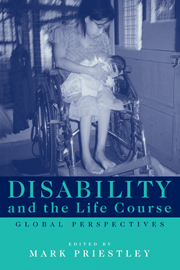Book contents
- Frontmatter
- Contents
- List of figures
- List of tables
- Notes on contributors
- Preface
- Acknowledgements
- A brief note on terminology
- I Concepts
- 1 Introduction: the global context of disability
- 2 Repositioning disability and the life course: a social claiming perspective
- 3 Marginalisation and disability: experiences from the Third World
- 4 Where do we draw the line?: surviving eugenics in a technological world
- 5 A complicated struggle: disability, survival and social change in the majority world
- II Methods and stories
- III The politics of transition
- Index
1 - Introduction: the global context of disability
Published online by Cambridge University Press: 30 September 2009
- Frontmatter
- Contents
- List of figures
- List of tables
- Notes on contributors
- Preface
- Acknowledgements
- A brief note on terminology
- I Concepts
- 1 Introduction: the global context of disability
- 2 Repositioning disability and the life course: a social claiming perspective
- 3 Marginalisation and disability: experiences from the Third World
- 4 Where do we draw the line?: surviving eugenics in a technological world
- 5 A complicated struggle: disability, survival and social change in the majority world
- II Methods and stories
- III The politics of transition
- Index
Summary
Disability is a global issue. More than half a billion disabled people live in the world today – approximately one in ten of the population. This number is set to rise dramatically over the next twenty-five years, both in richer technological societies and in the poorer majority (International Disability Foundation 1998). At the same time, disabled people throughout the world are empowering themselves to claim greater participation, integration and equality. Such claims are not only about greater control over individual lives but also about greater influence over the social structures within which such lives are lived. For this reason, it is impossible to disentangle the lived experience of disability from the context of disabling societies. They are part of the same story. The various contributions in this book demonstrate the complexity of this connection and reveal how disabling barriers and enabling strategies interact in a changing world.
Uneven economic and political development means that impairment and disability affect children, adults and older people differently in different societies. According to United Nations (UN) estimates, around 80 per cent of disabled people live in so-called ‘developing’ countries. More accurately, we might say that most disabled people spend most of their lives in the ‘majority world’ (Stone 1999). Yet, the academic literature of disability studies consistently privileges minority world accounts (especially, those from Western Europe and North America).
- Type
- Chapter
- Information
- Disability and the Life CourseGlobal Perspectives, pp. 3 - 14Publisher: Cambridge University PressPrint publication year: 2001
- 8
- Cited by



